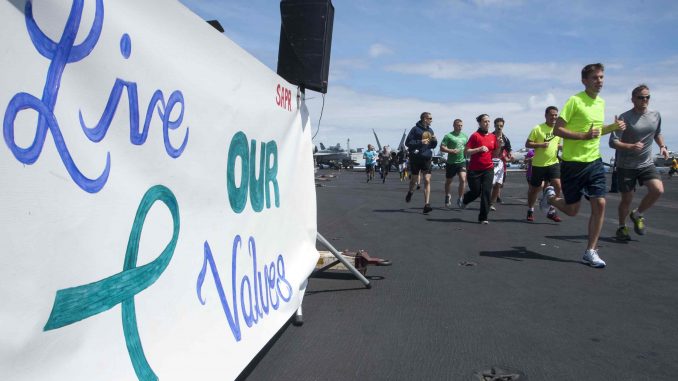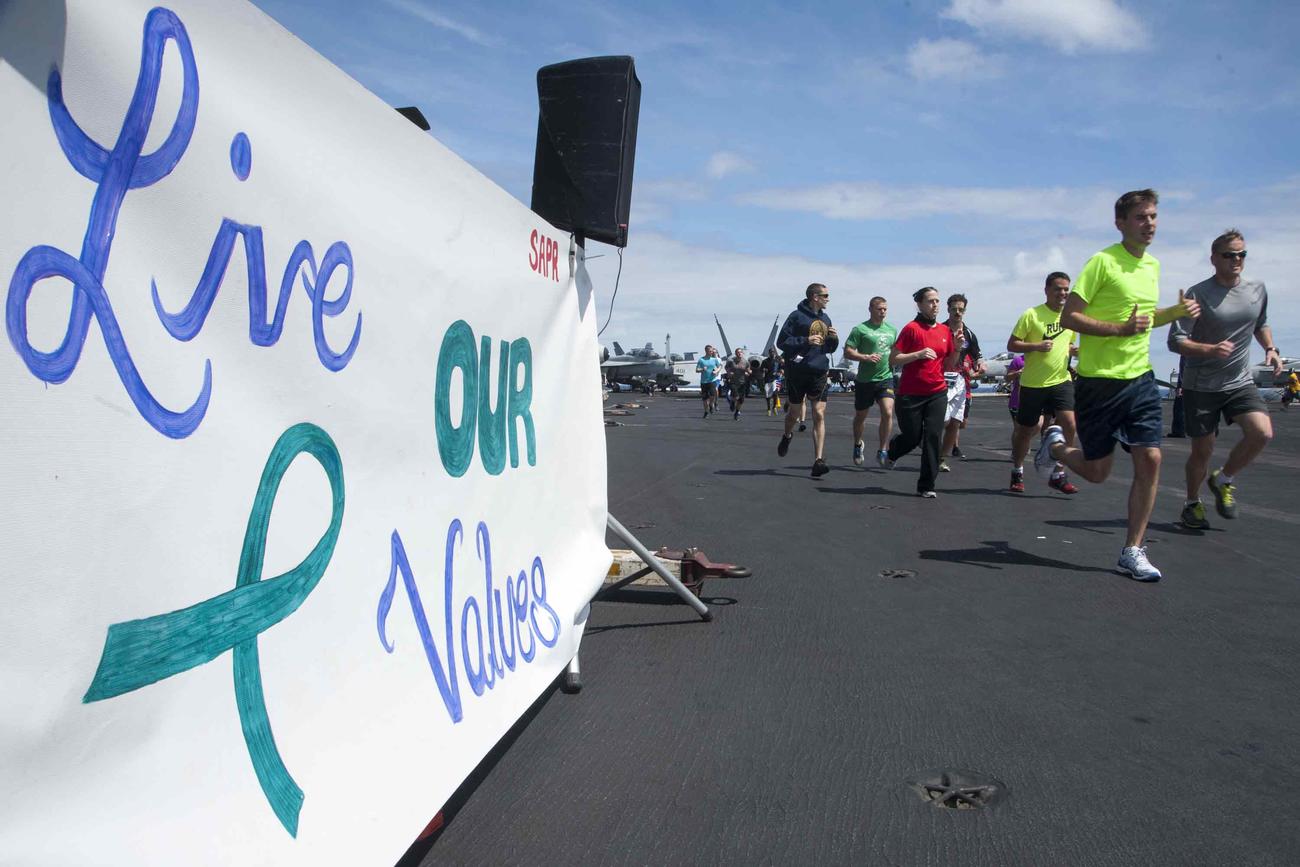

Reports of sexual assault and sexual harassment continue to rise in the U.S. military, with more than 60% of all investigated cases in 2019 being between service members.
The Defense Department’s annual Report on Sexual Assault in the Military, released Thursday, said there were 7,825 cases of sexual assault reported in fiscal 2019, up 3% from 6,326 reported in fiscal 2018.
The figures include more than 3,000 reports filed by a service member that prompted criminal investigations against another member, and 652 reports of sexual assaults that occurred before the victim joined the military.
Of the total number, 3,219 reports were made in the Army, a 2% increase from fiscal 2018; 1,774 were Navy, up 4.5%; the Air Force, with 1,683 reports, up 9%; and the Marine Corps, with 1,149 cases, down from 1,228, a 6% drop.
Since 2013, the Marine Corps and the Army have consistently had the highest reporting rates among the services: In 2019, the reporting rate for the Army was 5.5 per thousand service members; the Marine Corps’ was 5.4 per thousand; the Navy was 5.0 per thousand; and the Air Force was 4.6 per thousand. The rate for all services across DoD was 5.1 per thousand troops.
From fiscal 2018 to 2019, the overall DoD and Army reporting rates stayed constant. The Navy and Air Force reporting rates increased year over year by .2 and .3 per thousand, respectively, and the Marine Corps rate decreased by .3 per thousand.
Pentagon officials said the increase in reports cannot be construed as an increase in the number of sexual assault in the ranks, estimated to be 20,500 in fiscal 2018, according to a survey conducted every two years among service members.
Instead, they said, focus groups held this year indicate that the increase may be due to commanders encouraging reporting, conducting sexual assault prevention training and portraying sexual assault as a readiness problem.
Also, comments from the focus groups showed that military culture may be “heading in the right direction, albeit slowly,” according to the report.
“Previously admissible ‘locker room’ behaviors face greater scrutiny today, in part due to younger service members being more aware of what constitutes inappropriate behavior,” the report stated. “Participants indicated that generational differences may impact progress in enhancing healthy workplace climates.”
“One of our prevention efforts over the past year focused on preparing leaders at all levels to better reach our youngest Service members who are most at risk,” said Nate Galbreath, acting director of the DoD’s Sexual Assault Prevention and Response Office. “Helping our newest enlisted leaders and supervisors create healthy unit climates will benefit our military and all those who serve.”
The report also showed, however, that the services still struggle to encourage service members to report their offenders and pursue prosecution. The number of “unrestricted reports” — the type that prompts an investigation and allows for legal proceedings against the perpetrator — decreased by 2% from the previous year.
Related: Sexual Assault Reports Increased Last Year Across Military Academies
Focus groups indicated that poor command climates at some units discourage reporting and service members also continue to fear retaliation for coming forward with an allegation of sexual assault and worry that their report will be made public.
The report is the first to contain data from a program instituted last year known as Catch a Serial Offender, or CATCH. It allows active-duty personnel or adult family members to file a restricted report — one that does not trigger an investigation — to determine whether the suspect has previous charges or complaints.
As of April, 239 service members had made reports into the CATCH program, resulting in 5 “matches,” which were then reported back to the victims to give them the opportunity to file an unrestricted report.
Army Secretary Ryan McCarthy and Army Chief of Staff Gen. James McConville said the report highlights the need to continue prevention programs and interventions to eliminated sexual assault in the ranks.
“Sexual assault is a deliberate fratricide that tears at the fabric of our organization and erodes readiness,” they said in a prepared statement. “We continue our efforts to cultivate a culture of trust, respect and inclusion by encouraging reporting, supporting victims, and holding offenders accountable.”
Marine Corps officials, seeing a decline in reports in 2019 after experiencing a sharp increase in 2018, said it is “too soon to tell” whether the decline is “an anomaly or the start of a trend.”
Maj. Craig Thomas, a spokesman for Marine Corps Manpower and Reserve Affairs, said the service has increased its focus on prevention and working to “foster a climate and culture of dignity, respect and trust.”
“Senior Marine leaders do not necessarily equate lower reports of sexual assault with lower instances of this offense,” Thomas said. “Marines have a fundamental right to live and work in a healthy environment free from sexual assault and harassment.
Of the 3,716 reports considered for action by commanders, 63% received some type of punishment, with 49% of those referred to court martial and 29% receiving an administrative action or discharge. Nearly a quarter received nonjudicial punishment.
According to the report, the military received 1,021 formal sexual harassment complaints in fiscal 2019, a 10% increase from the previous year. Last year, DoD made sexual harassment a criminal offense under the Uniform Code of Military Justice.
Focus groups showed that service members continue to struggle tp understand what constitutes sexual harassment, saying it is perception-based and viewed differently by males and females. They added that when they see it occur, it’s not always addressed, perhaps out of concern for jeopardizing someone’s career.
It would be hard to dispute, however, several instances of obvious sexual harassment that focus group members discussed.
A junior enlisted female Marine said she bent over to get something without realizing anyone was around. “Bent over to grab something really quick and a sergeant is behind me and said, ‘Oh, don’t tempt me,’” she recalled.
“I come in [in civilian] clothes in the morning and I’ve had people say, ‘Well [explicit], I didn’t know you had all that,’” said a mid-level Navy enlisted female sailor.
The report follows one earlier this year that showed a 32% increase in the number of sexual assault reports at the U.S. service academies. But as with the report released Thursday, the Pentagon needs more information to determine whether the increased number of reports actually indicates an increase in sexual assaults or whether it just shows variances in reporting.
DoD conducts a survey every two years of active-duty troops to assess the scope of the problem across the ranks.
–Patricia Kime can be reached at Patricia.Kime@Monster.com. Follow her on Twitter @patriciakime.
Read More: Pentagon Program Seeks Victims’ Help in Catching Serial Sex Offenders
© Copyright 2020 Military.com. All rights reserved. This material may not be published, broadcast, rewritten or redistributed.






Be the first to comment